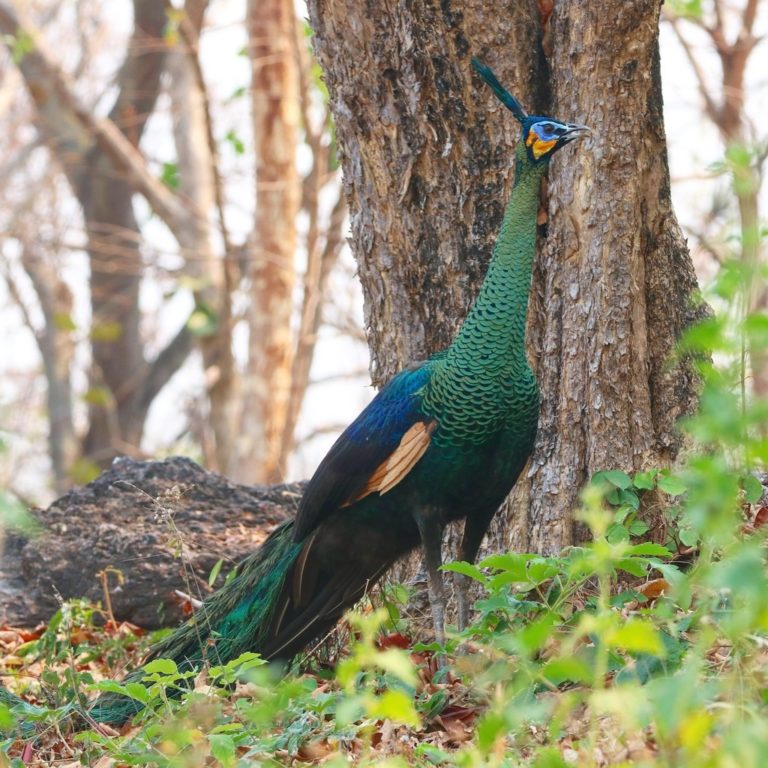Birdfinding.info ⇒ The magnificent Green Peafowl is rare, endangered, and declining overall, but still locally common and observable in several protected areas where it is a centerpiece of conservation and ecotourism. Some of the more convenient sites where it can be found reliably include: in Myanmar, Hlawga National Park just north of Yangon; in Thailand, Doi Pha Hom Pok and Doi Suthep – Pui National Parks, Ban Hong, Khao Soi Dao, and Huai Kha Kaeng Wildlife Sanctuaries, and the Huai Hong Khrai Royal Project Area; in Cambodia, Seima Protected Forest and Snoul Wildlife Sanctuary; in Vietnam, Cát Tiên National Park; and on Java, Ujung Kulon, Ales Purwo, and Baluran National Parks.
Green Peafowl
Pavo muticus
Southeastern Asia and Indonesia, where it occurs in open woodlands and savannas, usually near waterbodies or streams, from lowlands up to at least 2,100 m elevation.
Formerly occurred across much of southeastern Asia from eastern India and Bangladesh to Yunnan and south through most of Indochina and the Malay Peninsula to Java. Current range is a small fraction of that area. In 2018, the total global population was estimated at 15,000 to 30,000.
Fragmentary populations persist across much of Myanmar, the length of the Irawaddy Valley, eastward to central Yunnan, western Laos, and north-central and western Thailand.
In southern Indochina, it still occurs in northern, southwestern, and eastern Cambodia and adjacent areas of southern Vietnam.
On Java, it is apparently confined to the far western tip (Ujung Kulon National Park) and a larger area at the far eastern end of the island.
Identification
Male is among the most elegant and spectacular of birds: turkey-sized, tall, slender, long-legged, with a rigid, vertical crest, glistening green, blue, and golden plumage, and an extravagant tail that can exceed 2 meters long. From tip to tip, the male’s total length is up to about 3 meters.
The pattern of its tail (actually extended uppertail coverts) is similar to that of its more familiar, smaller relative, the Indian Peafowl, with shaggy, moss-green filaments and blue-and-coppery “eye-spots.” When displaying, the male fans the tail and holds it vertical—in the fashion for which peacocks are known.

Green Peafowl, male. (Ales Purwo National Park, Java, Indonesia; August 9, 2019.) © Chris Barnes
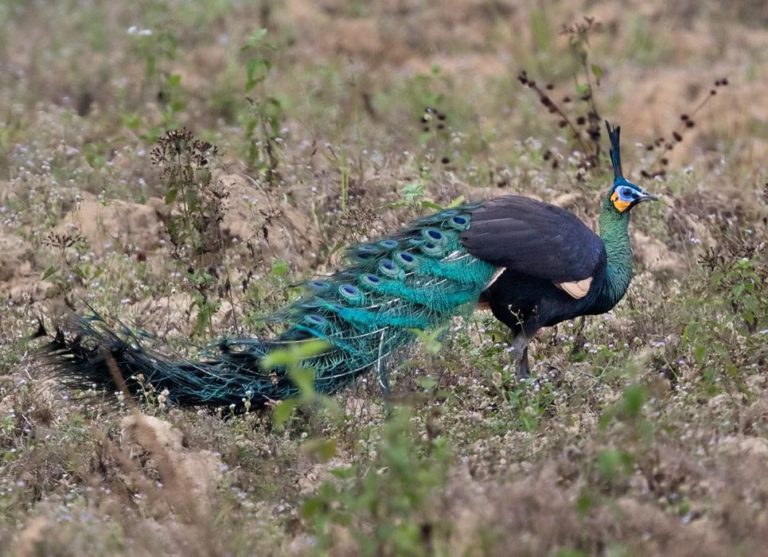
Green Peafowl, male. (Cát Tiên National Park, Dong Nai, Vietnam; February 27, 2018.) © Lars Petersson
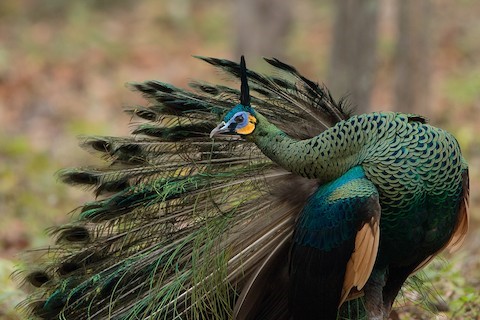
Green Peafowl, male. (Ban Hong Wildlife Sanctuary, Lamphun, Thailand; January 6, 2018.) © Ayuwat Jearwattanakanok
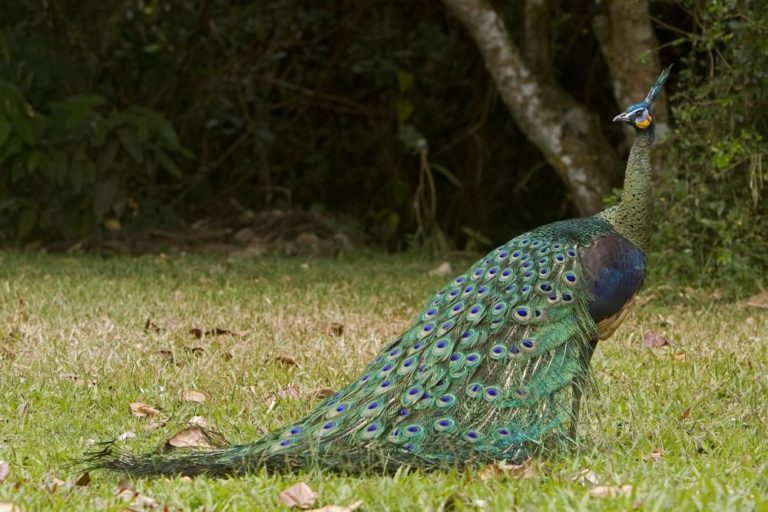
Green Peafowl, male showing eye-spot-pattern on the tail. (Khao Soi Dao Wildlife Sanctuary, Thailand; December 23, 2014.) © Henrik Bringsøe

Green Peafowl, male. (Ban Hong Wildlife Sanctuary, Lamphun, Thailand; March 13, 2019.) © Tim Avery

Green Peafowl, male—note exceptionally large feet. (Baluran National Park, Java, Indonesia; July 22, 2010.) © Lars Petersson
The wings and belly are mostly blackish, except the primaries which are a pale coppery-buff.
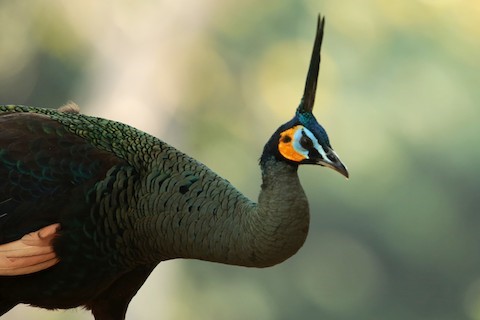
Green Peafowl, male showing boldly patterned bare facial skin and rigid, vertical crest. (Hlawga National Park, Myanmar; January 11, 2017.) © Aaron Maizlish
The facial skin is bare and brightly colored: pale-blue with a yellow-orange crescent on the cheek, and black streaks across the eye and ear.
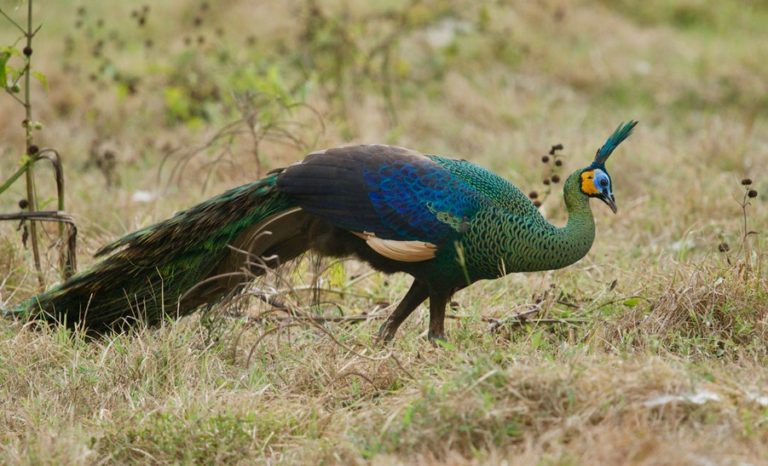
Green Peafowl, male. (Ales Purwo National Park, Java, Indonesia; July 18, 2018.) © Qin Huang
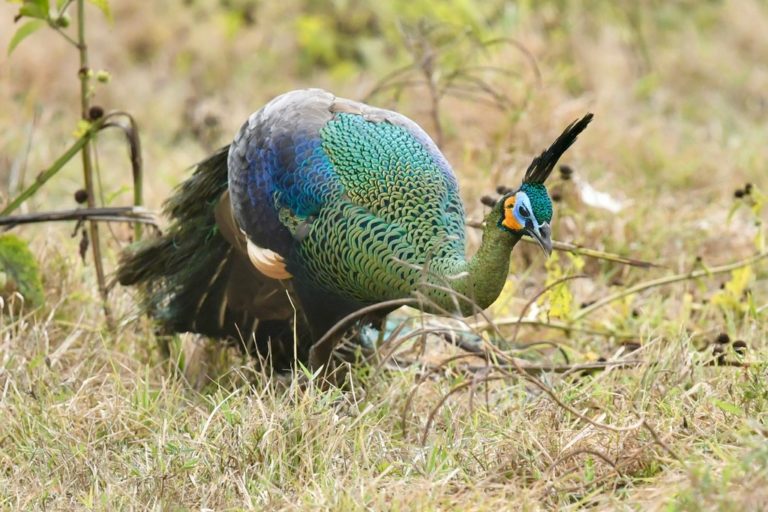
Green Peafowl, male. (Ales Purwo National Park, Java, Indonesia; July 18, 2018.) © Qin Huang
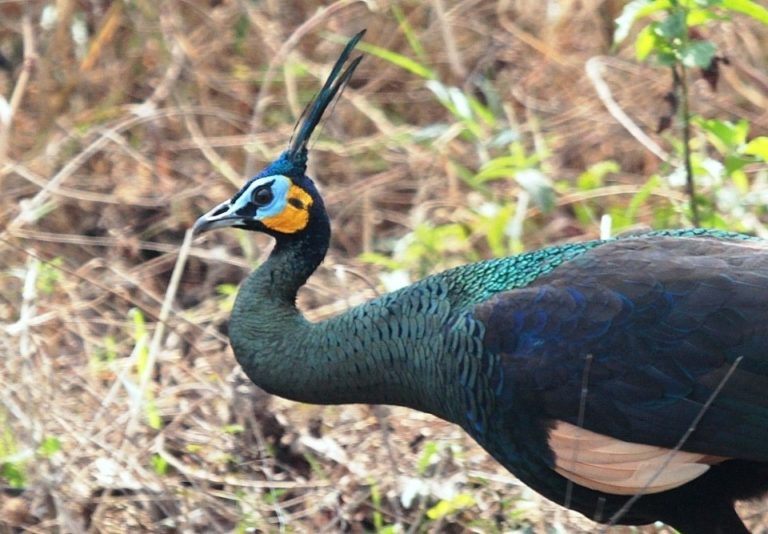
Green Peafowl, male showing boldly patterned bare facial skin and rigid, vertical crest. (Hlawga National Park, Myanmar; February 19, 2016.) © subhashc
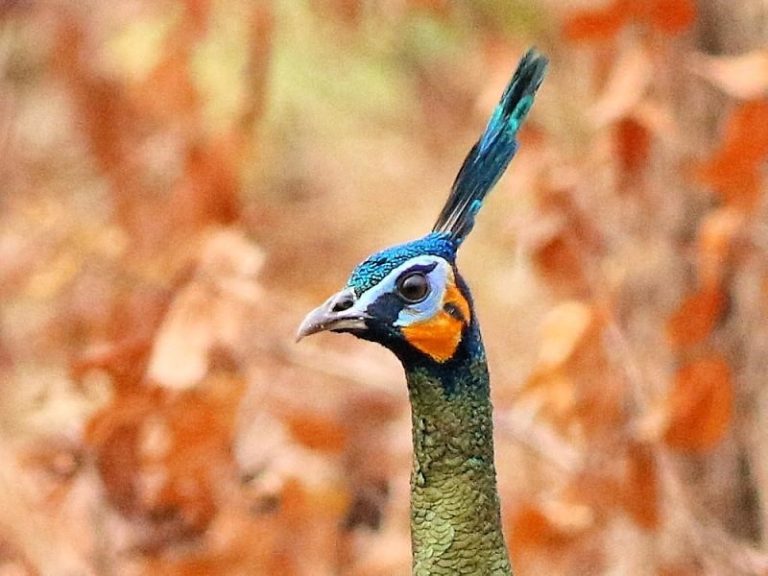
Green Peafowl, male showing boldly patterned bare facial skin and rigid, vertical crest. (Tmatboey, Preah Vihear, Cambodia; March 8, 2017.) © David Cooper
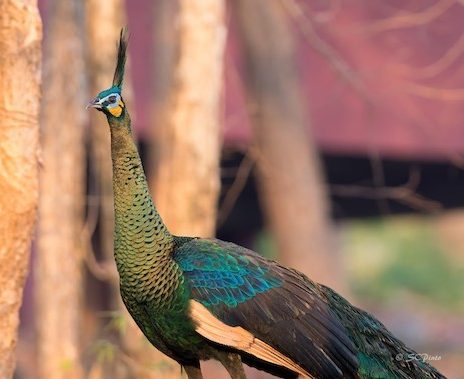
Green Peafowl, male showing iridescent golden tones on neck and turquoise on back. (Ban Hong Wildlife Sanctuary, Lamphun, Thailand; March 7, 2019.) © Shailesh Pinto
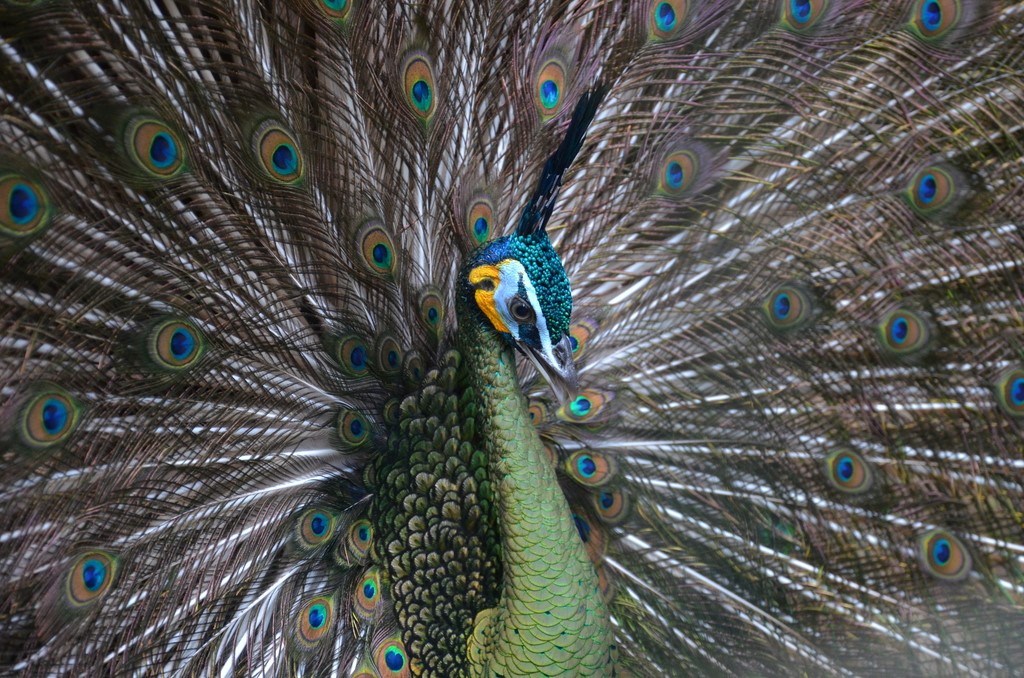
Green Peafowl, male displaying. (Indonesia; April 28, 2019.) © Ji-Shen Wang
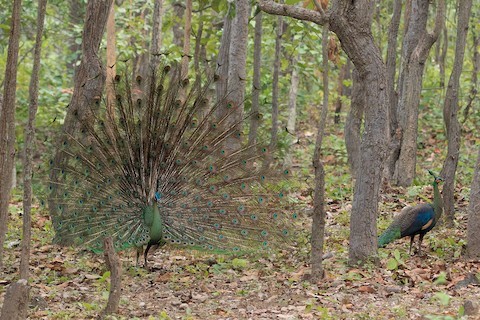
Green Peafowl, male displaying to female. (Ban Hong Wildlife Sanctuary, Lamphun, Thailand; January 6, 2018.) © Ayuwat Jearwattanakanok

Green Peafowl, male displaying to female. (Baluran National Park, Java, Indonesia; August 27, 2008.) © Mehd Halaouate
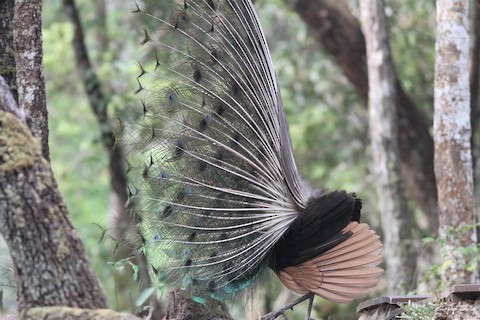
Green Peafowl, male displaying, side-view showing coppery-buff primaries. (Phu Khieo Wildlife Sanctuary, Chaiyaphum, Thailand; March 8, 2016.) © Mark Hogarth
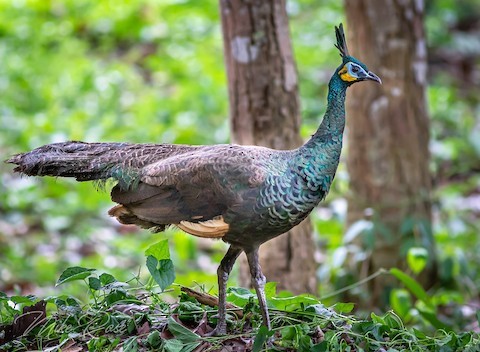
Green Peafowl, female. (Tat Mok National Park, Phetchabun, Thailand; June 12, 2019.) © Mike Rose
The female resembles the male, but lacks the extravagant tail coverts.

Green Peafowl, females. (Ales Purwo National Park, Java, Indonesia; August 9, 2019.) © Chris Barnes
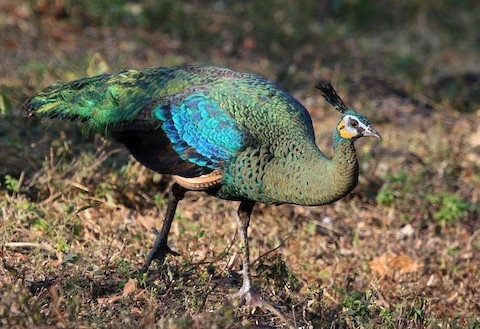
Green Peafowl, female. (Ban Hong Wildlife Sanctuary, Lamphun, Thailand; February 6, 2020.) © Stuart Kelly

Green Peafowl, close view of bare facial skin. (Ban Hong Wildlife Sanctuary, Lamphun, Thailand; March 13, 2019.) © Tim Avery
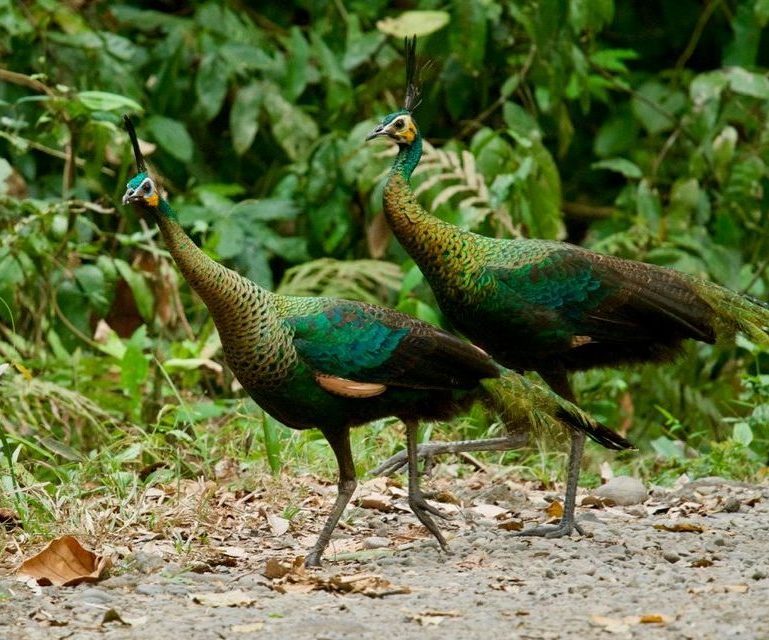
Green Peafowl, females. (Ales Purwo National Park, Java, Indonesia; July 18, 2018.) © Qin Huang

Green Peafowl, female in flight. (Baluran National Park, Java, Indonesia; July 27, 2008.) © Mehd Halaouate
Voice. Male gives a loud, mournful trumpeting call:
Notes
Polytypic species consisting of three recognized subspecies.
IUCN Red List Status: Endangered.
References
BirdLife International. 2018. Pavo muticus. The IUCN Red List of Threatened Species 2018: e.T22679440A131749282. https://dx.doi.org/10.2305/IUCN.UK.2018-2.RLTS.T22679440A131749282.en. (Accessed March 12, 2020.)
eBird. 2020. eBird: An online database of bird distribution and abundance. Cornell Lab of Ornithology, Ithaca, N.Y. http://www.ebird.org. (Accessed March 12, 2020.)
Madge, S., and P.J.K. McGowan. 2002. Pheasants, Partridges, and Grouse: A Guide to the Pheasants, Partridges, Quails, Grouse, Guineafowl, Buttonquails, and Sandgrouse of the World. Princeton University Press, Princeton, N.J.
McGowan, P.J.K., and G.M. Kirwan. 2020. Green Peafowl (Pavo muticus). In: del Hoyo, J., Elliott, A., Sargatal, J., Christie, D.A. & de Juana, E. (eds.). Handbook of the Birds of the World Alive. Lynx Edicions, Barcelona. https://www.hbw.com/node/53522. (Accessed March 12, 2020.)
Robson, C. 2002. Birds of Thailand. Princeton University Press, Princeton, N.J.
Xeno-Canto. 2020. Green Peafowl – Pavo muticus. https://www.xeno-canto.org/species/Pavo-muticus. (Accessed March 12, 2020.)
